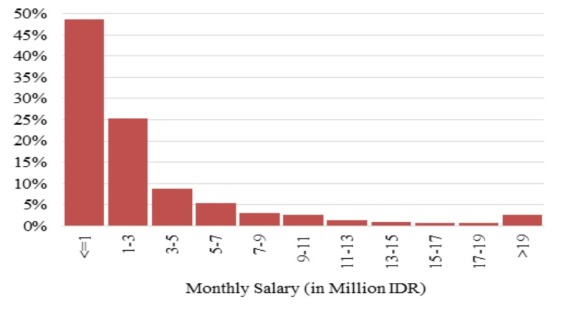Authored by:
Yudho Giri Sucahyo, Arfive Gandhi, A. Labib Fardany Faisal
Faculty of Computer Science, Universitas Indonesia, Depok, Indonesia
The online gig economy has been a trending topic in recent years. It offers flexibility for gig workers to search various kinds and scale of work via an online platform. It offers a different approach compared to conventional and routine 9 to 5 jobs. It enables people to organise their passion and time by selecting projects that fit their interests.
The Online Labour Index (OLI) as established by Oxford University announced a 26 percent increase in gig work from July 2016 to July 2017 [1]. Most workers came from the United States, United Kingdom, India, Australia, and Canada [2]. Surprisingly, India was included in the top five although it is a developing country with a high rate of unemployment.
This fact inspired a question of whether Indonesia also contributes to the online gig economy. If yes, how many online gig workers come from Indonesia and what benefits do they gain. Although Indonesia faces a digital divide, 65% (c.170m) citizens have access to the Internet [3]. Given the country has a 5% unemployment rate [4], the online gig economy offers a promising opportunity for the country to reduce its unemployment rate and increase individual income.
To answer the above questions, quantitative research was undertaken through data aggregation from various online gig platforms. Nine platforms were selected: Upwork.com, Freelancer.com, Fiverr.com, Peopleperhour.com, Guru.com, Sribulancer.com, Projects.co.id, Fastwork.id, and Microworkers.com. Web crawling and scraping were used as data collection techniques based on necessary information criteria.
Table 1 shows the results of our mini-research. We collected data from 171,033 Indonesian users of the above platforms at the end of October 2018. By considering that a gig worker is active when his/her latest project was no more than 28 days from the date of web crawling and scraping, out of 171,033 gig workers, only 2,062 were active, which is only 1.2%. The top three platforms used by gig workers in Indonesia are Fiverr, Upwork, and Projects.co.id. Fiverr had the most active Indonesian workers, and by far the highest percentage of Indonesian workers who were active.
Further information was also collected during web crawling and scraping to get more detail on the profile of Indonesian online gig workers: both field of work and income. As shown in Figure 1, most Indonesian online gig workers (c.50%) specialise in creative and multimedia, then followed by clerical and data entry (c.21%), writing and translation (c.14%), and software development and technology (c.12%). This suggests there may be a significant opportunity for Indonesia to strengthen its creative and multimedia industry and increase further its participation in the global online gig economy.
Table 1. Statistics of Indonesian Online Gig Workers
| Platform | Indonesian
Users |
Active Indonesian Gig Worker | Percentage (%) |
| Fiverr.com | 837 | 557 | 66.55 |
| Upwork.com | 13,945 | 449 | 3.22 |
| Projects.co.id | 115,558 | 428 | 0.37 |
| Freelancer.com | 16,639 | 187 | 1.12 |
| Sribulancer.com | 9,841 | 181 | 1.84 |
| Microworkers.com | 1,017 | 176 | 17.31 |
| Peopleperhour.com | 464 | 40 | 8.62 |
| Fastwork.id | 1,456 | 38 | 2.61 |
| Guru.com | 11,276 | 6 | 0.05 |

Figure 1. Distribution of Indonesian Online Gig Workers based on Field of Work
Breaking down field of work by platform (Figure 2), we see some differentiation, with some platforms hosting a mix of different work types but others showing signs of domination: creative and multimedia work on Fiverr; clerical and data entry work on Microworkers, which focuses on simple jobs in large volume.

Figure 2. Distribution of Indonesian Online Gig Workers on Each Platform
Income of Indonesian online gig workers is shown in Figure 3. Nearly 50% of workers earn IDR 1 million (c.US$70) or less per month and nearly 80% earn less than the minimum wage. However, many of these are likely to be part-time. Around one fifth of online gig workers earn more than IDR 5 million: above the minimum wage in any region in Indonesia. With the average income of Indonesian online gig workers being IDR 3.4 million (c.US$240), this suggests that there is some promise and opportunity for the online gig economy in Indonesia to reduce the unemployment rate by taking advantage of flexible jobs via online platforms.

Figure 3. Distribution of Indonesian Online Gig Worker Income
References
[1] V. Lehdonvirta, The online gig economy grew 26% over the past year, available on http://ilabour.oii.ox.ac.uk/the-online-gig-economy-grew-26-over-the-past-year/
[2] O. Kassi, V. Lehdonvirta, “Online Labour Index: Measuring the Online Gig Economy for Policy and Research”, Technological Forecasting & Social Change, pp. 1-8, 2018.
[3] APJII, “Indonesia Internet Users Behaviour Profile, a Survey Report”, 2018.
[4] Trading Economics, Unemployment Rate | Asia, available on https://tradingeconomics.com/indonesia/unemployment-rate
